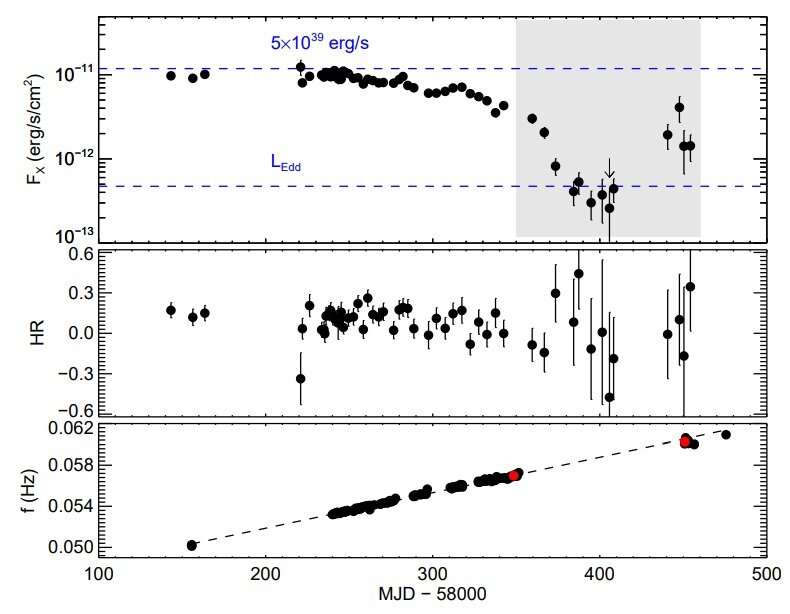May 22, 2019 report
Ultra-luminous X-ray pulsar NGC 300 ULX1 experienced unprecedented spin evolution, study finds

Using NASA's Swift space telescope and NICER instrument aboard the International Space Station (ISS), astronomers have investigated the properties of an ultra-luminous X-ray pulsar known as NGC 300 ULX1. Results of this study, presented in a paper published May 9 on the arXiv preprint server, indicate that this object experienced an unprecedented spin evolution as its spin period decreased significantly during a timespan of four years.
Ultra-luminous X-ray sources (ULXs) are point sources in the sky that are so bright in X-rays that each emits more radiation than 1 million suns emit at all wavelengths. Although they are less luminous than active galactic nuclei (AGN), they are more consistently luminous than any known stellar process.
Some ULXs showcase coherent pulsations. These sources, known as ultra-luminous X-ray pulsars (ULXPs), are neutron stars typically less massive than black holes. The list of known ULPs is still relatively short, hence detailed observations of so far detected objects of this class are essential for researchers studying the universe in X-rays.
NGC 300 ULX1 is an ULXP located some 6.13 million light years away in the spiral galaxy NGC 300. Discovered in 2010, the source was initially classified as a supernova, but later reclassified as a possible high-mass X-ray binary. However, a study published in November 2018 revealed pulsations from NGC 300 ULX1, which confirmed its ULXP nature.
Following its detection, NGC 300 ULX1 has been monitored by a group of astronomers led by Georgios Vasilopoulos of Yale University in order to get insights about the pulsar's properties. For this purpose, they used the Neil Gehrels Swift Observatory and the Neutron Star Interior Composition ExploreR (NICER) attached to ISS. Data from these two instruments allowed them to obtain important information about the spin evolution of this object.
By analyzing new data and also the results of other observations of NGC 300 ULX1, the astronomers found that the spin period of this pulsar decreased from 126 seconds to less than 20 seconds in just four years. They added that such behavior is consistent with a steady mass accretion rate, noting that the neutron star continues to spin up with a rate indicating a constant mass accretion rate within 2018.
Furthermore, the study found that the observed X-ray flux of NGC 300 ULX1 dropped by a factor of about 20 to 30 from its peak value in 2018. However, although this value decreased, the researchers noted that the spin-up rate of the neutron star remained roughly constant.
Trying to explain the drop in the observed X-ray flux, the authors of the paper assume that it could be a result of increased absorption and obscuration.
"A possible explanation is that the decrease in the observed flux is a result of increased absorption of obscuring material due to outflows or a precessing accretion disk. (…) Outflows from a radiation-dominated accretion disk can provide an optically thick structure that could be responsible for the increased absorption," the astronomers concluded.
More information: G. Vasilopoulos, et al. NGC 300 ULX1: spin evolution, super-Eddington accretion and outflows. arXiv:1905.03740v1 [astro-ph.HE]. arxiv.org/abs/1905.03740
© 2019 Science X Network





















